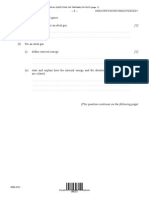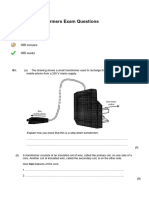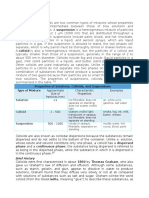B4 Worksheet3
B4 Worksheet3
Uploaded by
Shalini KulshresthaCopyright:
Available Formats
B4 Worksheet3
B4 Worksheet3
Uploaded by
Shalini KulshresthaOriginal Title
Copyright
Available Formats
Share this document
Did you find this document useful?
Is this content inappropriate?
Copyright:
Available Formats
B4 Worksheet3
B4 Worksheet3
Uploaded by
Shalini KulshresthaCopyright:
Available Formats
– 12 – M19/4/PHYSI/SP3/ENG/TZ1/XX
(Option B continued)
7. (a) Show that during an adiabatic expansion of an ideal monatomic gas the temperature T
and volume V are given by [2]
2
TV 3 constant
..........................................................................
..........................................................................
..........................................................................
..........................................................................
(b) The diagram shows a Carnot cycle for an ideal monatomic gas.
P
A
The highest temperature in the cycle is 620 K and the lowest is 340 K.
(i)
..........................................................................
..........................................................................
(Option B continues on the following page)
– 13 – M19/4/PHYSI/SP3/ENG/TZ1/XX
(Option B, question 7 continued)
(ii) B is 540 J. Calculate the
thermal energy that leaves the gas during one cycle. [2]
..........................................................................
..........................................................................
..........................................................................
..........................................................................
VC
(iii) Calculate the ratio where VC is the volume of the gas at C and VB is the
VB
volume at B. [2]
..........................................................................
..........................................................................
..........................................................................
..........................................................................
..........................................................................
..........................................................................
(c) (i) Calculate the change in the entropy of the gas during the change A to B. [1]
..........................................................................
..........................................................................
(ii) Explain, by reference to the second law of thermodynamics, why a real engine
operating between the temperatures of 620 K and 340 K cannot have an
..........................................................................
..........................................................................
..........................................................................
..........................................................................
End of Option B
Turn over
You might also like
- FE Math PracticeDocument8 pagesFE Math PracticeAdam Wilkins71% (7)
- Ib Physics HL Review Packet - ThermodynamicsDocument19 pagesIb Physics HL Review Packet - ThermodynamicsGhenwa DimachkiNo ratings yet
- Solar radiation-WSDocument2 pagesSolar radiation-WSPrisha GargNo ratings yet
- DC CircuitDocument2 pagesDC CircuitChocomalteeChocomaltee100% (1)
- Chem Ib PaperDocument18 pagesChem Ib Paperembededodin0% (1)
- 2021 Sda F5 June Test 1Document11 pages2021 Sda F5 June Test 1blueegofxNo ratings yet
- P3 11 TransformersDocument65 pagesP3 11 Transformersisaaceden24No ratings yet
- Thermal Physics CoreDocument8 pagesThermal Physics Corerohit.makwanaNo ratings yet
- IB-1 Thermal Properties & Calorimetry PracticeDocument3 pagesIB-1 Thermal Properties & Calorimetry PracticeGajendraNo ratings yet
- Black Body Radiation 3 QPDocument11 pagesBlack Body Radiation 3 QPNaeemNo ratings yet
- Black Body Radiation 3 QPDocument11 pagesBlack Body Radiation 3 QPGbenga AjibikeNo ratings yet
- FT 12 Gr10 P2 Qs (Energy) PDFDocument7 pagesFT 12 Gr10 P2 Qs (Energy) PDFMuhammad ObaidullahNo ratings yet
- B1B2_Mix_2024_printDocument19 pagesB1B2_Mix_2024_printtelepathicai7No ratings yet
- Domestic Uses - Safety 2 QPDocument13 pagesDomestic Uses - Safety 2 QPGbenga AjibikeNo ratings yet
- 3.1 Thermal PhysicsDocument10 pages3.1 Thermal Physicsmardel11No ratings yet
- 4 Ideal Gas0001Document18 pages4 Ideal Gas0001Pooja MehraNo ratings yet
- Topic 3. Thermal Heating Long QDocument11 pagesTopic 3. Thermal Heating Long Qjh seoNo ratings yet
- Thermal Properties & Temperature 2 QPDocument9 pagesThermal Properties & Temperature 2 QPJinYoongLimNo ratings yet
- Topic 3 Test - Paper 2Document2 pagesTopic 3 Test - Paper 2IB BaddiesNo ratings yet
- Ejercicios BIDocument596 pagesEjercicios BIESTEBAN JUNINHO CAICEDO PIEDRANo ratings yet
- P1a-H-mock-1Document23 pagesP1a-H-mock-1Marwa AliNo ratings yet
- 22.2-Thermal Properties and Temperature-Cie Igcse Physics Ext-Theory-QpDocument10 pages22.2-Thermal Properties and Temperature-Cie Igcse Physics Ext-Theory-QpDaniel goodchildNo ratings yet
- Black Body Radiation 2 QPDocument16 pagesBlack Body Radiation 2 QPNaeemNo ratings yet
- Thermal Properties - 9-18Document25 pagesThermal Properties - 9-18Aryan SinghNo ratings yet
- Thermal Properties - 9-18Document25 pagesThermal Properties - 9-18Aryan SinghNo ratings yet
- Unit 2 - TestDocument5 pagesUnit 2 - Testevioktavianti260619No ratings yet
- Domestic Uses & Safety 2 QPDocument13 pagesDomestic Uses & Safety 2 QPemily3brow8nNo ratings yet
- Black Body Radiation 2 QPDocument16 pagesBlack Body Radiation 2 QPGbenga AjibikeNo ratings yet
- P1 - Heat TransferDocument16 pagesP1 - Heat Transferreda100% (1)
- Set 62 - Chapter 2Document12 pagesSet 62 - Chapter 2lelon81No ratings yet
- Capacitors Revision Worksheet: Addu High School Hithadhoo/AdduDocument8 pagesCapacitors Revision Worksheet: Addu High School Hithadhoo/AdduDhan Bahadhur Mr.Dhan Bahadur BoharaNo ratings yet
- Energy and Thermal Extra Questions PDFDocument29 pagesEnergy and Thermal Extra Questions PDFsib menoNo ratings yet
- Thermal ExtDocument9 pagesThermal Extrohit.makwanaNo ratings yet
- physicsp32001Document13 pagesphysicsp32001Pri NgieNo ratings yet
- Induced Potential, Transformers - National Grid 2 QPDocument16 pagesInduced Potential, Transformers - National Grid 2 QPGbenga AjibikeNo ratings yet
- Revision Questions PDFDocument9 pagesRevision Questions PDFmwagweNo ratings yet
- Thermodynamics WS mergedDocument46 pagesThermodynamics WS mergedkaziabdulmuizNo ratings yet
- P1 3 The Usefulness of Electrical Appliances StandDocument59 pagesP1 3 The Usefulness of Electrical Appliances StandjesudassajNo ratings yet
- Internal Energy 3 QPDocument18 pagesInternal Energy 3 QPAidan MatthewsNo ratings yet
- Unit 4 - TestDocument7 pagesUnit 4 - Testevioktavianti260619No ratings yet
- Energy Transfers 3 QPDocument15 pagesEnergy Transfers 3 QPemily3brow8nNo ratings yet
- 2 HoursDocument17 pages2 HoursOTTO OLIMANo ratings yet
- Paper 4Document11 pagesPaper 4Myat Thura KyawNo ratings yet
- P1 04 Heating and Insulating BuildingsDocument85 pagesP1 04 Heating and Insulating Buildingsramyelgebaly04No ratings yet
- Test Chem 1,2Document7 pagesTest Chem 1,2Hassan KhanNo ratings yet
- This Section Consists of Four Questions: B1, B2, B3 and B4. Answer Two QuestionsDocument2 pagesThis Section Consists of Four Questions: B1, B2, B3 and B4. Answer Two QuestionsJorge ChavezNo ratings yet
- Thermal Physics ExtendedDocument9 pagesThermal Physics Extendedrohit.makwanaNo ratings yet
- Work, Energy & Power-AQADocument16 pagesWork, Energy & Power-AQAmzzha3No ratings yet
- BondingDocument14 pagesBondingMuizzudin AzaliNo ratings yet
- ST 12 Gr10 P2 Qs (Introductory Electronics) PDFDocument10 pagesST 12 Gr10 P2 Qs (Introductory Electronics) PDFSaleem ShahidNo ratings yet
- Water and Hydrogen Chemistry Form 1 Topical Questions and AnswersDocument7 pagesWater and Hydrogen Chemistry Form 1 Topical Questions and AnswersbramswelmNo ratings yet
- SL Topic 1 - 2009 - 2015Document82 pagesSL Topic 1 - 2009 - 2015principal.jakkurNo ratings yet
- Internal Energy 1 QPDocument20 pagesInternal Energy 1 QPGbenga AjibikeNo ratings yet
- Energetics QuestionsDocument20 pagesEnergetics Questionslianchen251110No ratings yet
- P2 Revision Booklet Static Electricity: Medium (Grade C)Document10 pagesP2 Revision Booklet Static Electricity: Medium (Grade C)Prarthana VinothNo ratings yet
- National & Global Energy Resources 2 QPDocument15 pagesNational & Global Energy Resources 2 QPEman RizwanNo ratings yet
- 3.1 Cons. of Mass, Chemical Measurements & Eqns 2 QP-1Document18 pages3.1 Cons. of Mass, Chemical Measurements & Eqns 2 QP-1youssefelk.egNo ratings yet
- 3 8 1 7-Induced-FissionDocument49 pages3 8 1 7-Induced-FissionSack YomamNo ratings yet
- Reversed Heat Engines QPDocument4 pagesReversed Heat Engines QPYousef ElwakilNo ratings yet
- Current, Potential Difference - Resistance 3 QPDocument13 pagesCurrent, Potential Difference - Resistance 3 QPGbenga AjibikeNo ratings yet
- Igcse Electrochemistry Review PDFDocument7 pagesIgcse Electrochemistry Review PDFbilly ogada0% (1)
- Understanding Plastics Engineering Calculations: Hands-on Examples and Case StudiesFrom EverandUnderstanding Plastics Engineering Calculations: Hands-on Examples and Case StudiesNo ratings yet
- ConversionsDocument6 pagesConversionskurttakomeNo ratings yet
- 27 Jan Shift 2 PhysicsDocument5 pages27 Jan Shift 2 PhysicsK C DharshanNo ratings yet
- Vibration Analysis - Approximate Methods: Unit 4 - ContinuationDocument29 pagesVibration Analysis - Approximate Methods: Unit 4 - ContinuationAdrian ArasuNo ratings yet
- ADECO English PDFDocument28 pagesADECO English PDFpabulumzengNo ratings yet
- Entropy Generation in Two PhaseDocument26 pagesEntropy Generation in Two PhaseEss ZeeNo ratings yet
- Draft Survey MANUAL Canada PDFDocument96 pagesDraft Survey MANUAL Canada PDFoscar100% (2)
- (Progress in Nonlinear Differential Equations and Their Applications 23) Yuanlong Xin (Auth.) - Geometry of Harmonic Maps (1996, Birkhäuser Basel)Document251 pages(Progress in Nonlinear Differential Equations and Their Applications 23) Yuanlong Xin (Auth.) - Geometry of Harmonic Maps (1996, Birkhäuser Basel)Sergio Quisbert P.No ratings yet
- Jee Advanced Home Full Test Paper - 27-04-24Document31 pagesJee Advanced Home Full Test Paper - 27-04-24SAUMIL SINHANo ratings yet
- Triennale PDFDocument45 pagesTriennale PDFIsrael RiveraNo ratings yet
- Owner's Manual (KJR 08)Document4 pagesOwner's Manual (KJR 08)Catalino Peralta Segovia100% (1)
- Quantum PhysicsDocument65 pagesQuantum PhysicsAnonymous CUfCep0VNo ratings yet
- ME 308-Introduction To VibrationsDocument4 pagesME 308-Introduction To Vibrationssohail parachaNo ratings yet
- BiochemistryDocument10 pagesBiochemistryChithraNo ratings yet
- Polarization Notes FinalDocument4 pagesPolarization Notes Finalaerocj5002No ratings yet
- ME421-Single Degree of Freedom System (Damped) PDFDocument13 pagesME421-Single Degree of Freedom System (Damped) PDFAli Haider RizviNo ratings yet
- CBSE Test Paper 02 Chapter 3 Motion in A Straight LineDocument8 pagesCBSE Test Paper 02 Chapter 3 Motion in A Straight LineskNo ratings yet
- BET AssignmentDocument6 pagesBET AssignmentBala KumarNo ratings yet
- Colloidal DispersionDocument5 pagesColloidal DispersionCarlo HafallaNo ratings yet
- NSMQ Pasco FundamentalDocument34 pagesNSMQ Pasco FundamentalamadubabaabdulrahmanNo ratings yet
- Chemistry Unit Test Review Part II ADocument7 pagesChemistry Unit Test Review Part II AreBassistNo ratings yet
- Yearly Plan Chemistry Form 4Document16 pagesYearly Plan Chemistry Form 4Fion LimNo ratings yet
- Acb Ae 2000 SWDocument40 pagesAcb Ae 2000 SWDong Bach100% (1)
- Electronic Circuit SymbolsDocument15 pagesElectronic Circuit Symbolsramash75No ratings yet
- JEE Main Chapter Wise Weightage Physics 2023 2019Document5 pagesJEE Main Chapter Wise Weightage Physics 2023 2019rohit13339No ratings yet
- Mathematical Physics Sample Exam 1Document5 pagesMathematical Physics Sample Exam 1Perry EsguerraNo ratings yet
- LectureNotesBook PDFDocument187 pagesLectureNotesBook PDFyassinebouazziNo ratings yet
- Section 14.1 Electrostatic PhenomenaDocument13 pagesSection 14.1 Electrostatic Phenomenatwy113No ratings yet
- TCH ICPMSThirtyMinuteGuideDocument8 pagesTCH ICPMSThirtyMinuteGuideJimikovaNo ratings yet

























































































